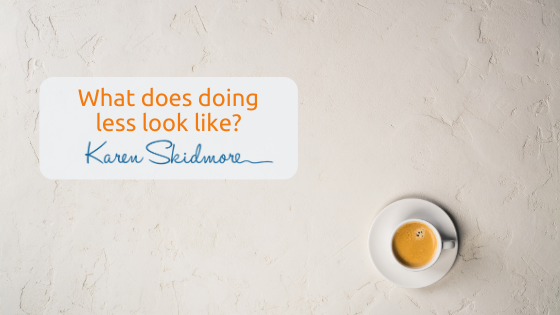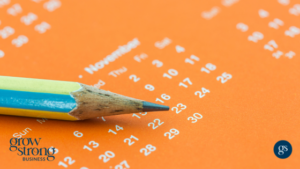What does doing less look like? This was a question that someone asked me this week (thanks Linda!). I write and talk a lot about the idea of doing less; my sign-off tag is Do Less, Be More, Play Bigger.
And I get that it can sound like a little abstract. Images of laying on the sofa, watching daytime TV and eating wotsits used to come to my mind whenever I was challenged that I may need to do less. But doing less isn’t about doing nothing. It is about what it says; doing less. As we are all living and breathing this create-more-in-less-time culture, it’s really easy to see how high our standards have got based on what we think we ‘should’ be doing during our days.
We have been obsessed with productivity long before we had smartphones.
The earliest known to-do list was recorded in 1791, with Benjamin Franklin’s “What good shall I do this day?” list.
The Industrial Revolution in the mid-1700’s birthed the beginnings of mechanical production, which kick-started the common goal of producing more in less time.
Through two World Wars, our workforce across the globe started to transform as factory production increased and office workers began their daily commutes. In the 1970’s, more people spent more time travelling to work and being at work, and we saw the creation of convenience foods and time saving household appliances so we could have more leisure time, and less time cooking and cleaning.
But the real acceleration of work productivity began to implode once home computers and the World Wide Web opened us to an endless stream of technology to make us more efficient.
Today, our smartphones can tell us how well we are eating, sleeping and running. We have access to an endless supply of productivity apps, automation systems and bluetooth devices all designed to send us constant notifications and help us do more in less time.
We can contact and be contacted by anyone, at any time.
Our work boundaries are so blurred that most of us now feel panicked if you ever leave the house without your smartphones and it’s reported that 71% of people sleep either holding their smartphone, having it in bed with them, or having it on their nightstand. It’s the first thing they look at when they wake and the last thing they see before they close their eyes at night.
Welcome to the never off society
But how productive are we?
Here in the UK, Britons are working an average of 42.5 hours a week. My guess is that those of us who run our own businesses may be doing upwards of double that, if you include all the hours spent on our phones, hatching out new plans and working away on client deadlines in the middle of the night.
Not surprisingly, it turns out that our mere mortal brains and bodies are simply not designed to be working this hard. We are working in a linear way throughout the year, not taking into account our seasonal cycles and daylight hours, and scheduling our days to a calendar created in Roman days that we have to add an extra day every four years to make it work with the earth’s natural orbit.
Today 79% of people at work are experiencing some level of burnout with nearly half of UK workers (48%) showing signs of moderate to severe burnout – only second to Japan (50%).
Back in 2012, I hit burnout hard. Still reeling from losing my dad to cancer two years previously, I found myself unable to function and couldn’t get out of bed one weekend. I can look back now and see all the signs; the extreme fatigue, brain fog, body in pain. But I had programmed myself to keep working hard at trying to get everything – life, business, family – to work.
I was sandwiched between life and business, squashing myself harder and harder as I tried to keep up with it all. It just felt easier to keep my head down and plough on because who was going to sign me off sick anyways?
That summer was the start of five years of horrid hormonal imbalance and peri-menopausal symptoms which I realised couldn’t be fixed with a pill or a two week holiday. I had to reset, reboot and take some serious rest. One of the areas I knew I needed to change was the way I was working, and I started on a journey of exploring and understanding what doing less actually meant.
So what does less actually look like?
First of all, why do less?
Plate spinning is one of the biggest problems I see in business; the thought that you can keep half a dozen projects going, all at the same time. In project management terms, you end up getting what would be called project creep. As you run around the plates, you aren’t going to get to them all. So they begin to slow and one day they begin to fall one by one, which in turn makes you run around even faster trying to pick them up and start them spinning all over again.
The maths is simple; the more projects (or client jobs or products to sell or social media profiles) you have to manage, the less chance you have of completing any. You try to find to-do list apps or project management software to help you organise it all and when you add in the dreaded procrastination gene that we all seem to have, you just never get to completion stage with any of the projects.
You are doing more than you ever thought possible and you still don’t think you are working hard enough … and thus starts the slippery slope of burnout.
So how can you start to do less?
First of all, you need to acknowledge that most of us are programmed to keep achieving, striving for more. Your productivity levels, no matter how efficient you think you are, can not keep up with the devices and apps that are designed to keep us all productive.
So the first step in doing less is giving yourself permission to do just one or two things really well. If you want to do more then you have to recognise the need to put in the infrastructure and teams to support you (so you aren’t the one doing all the doing). You have to get real about what you – a mere mortal – is capable of doing in a day.
There’s no quick fix (well, not that I can find!) but it all starts with getting conscious about your work habits and how you are approaching projects.
Before you even begin to start working out a new productivity routine (which IMO just triggers the must-do-more gene … more about this on another blog!), what I wanted to share with you today are three practical things you can do to get clear on what’s going for you:
1) First acknowledge that you have too many plates to spin.
If you don’t first admit that you have a plate spinning problem, then you won’t take any action to change your behaviour
2) Get conscious about your behaviour right now.
Before you make any changes, you need to see what you are doing first. You may find that in amongst all the chaos you feel around you, that there are some brilliant things you are doing. But if you don’t take the time to first see what’s going on, you won’t spot them. You may want to time track yourself for 2 or 3 days. This can feel like a painful process, especially if you’ve got a lot on already. But it doesn’t need to be complicated and you certainly don’t need a fancy app or software to do this. All you need is a piece of paper next to you throughout the day and just right down what you’ve done in one hour blocks. All you want to do is be able to spot the habits you are in, rather than go into analysis paralysis.
3) Get conscious about where your energies are at.
No matter what is going on in your life right now, your energy will be in ebb and flow. We are cyclical beings, women more so than men, and yet we are programmed to believe that good productivity is about sticking to routines. You will have your own natural rhythm that is influenced by so many things including the weather, the seasons, what you ate and drank the day before, your hormone cycles (women far more than men) and what is going on in your life.
Every morning I write down where I am in my menstrual cycle, what the weather is outside, how well I slept, where the moon is in its cycle and anything else that I feel is worth noting. What this does is help me get body conscious of what is going for me so if it’s raining hard, I’m day 25 of my cycle and there’s a full moon about to happen, I know I may be a little more emotional and tired than usual. I can then be that little bit more kinder with myself and give myself less to do that day.
I’m going to be sharing more on this topic of doing less over the next few weeks so if you are interested in finding out more, make sure you are signed up for my updates. But for now, I would love you to do these three things and let me know what impact it has on your week.
You may just surprise yourself and realise there is far less to fix than you originally thought 🙂
Until next time, do less, be more and play bigger.









Hi Karen, I read your email and article. It’s a fascinating debate as we have been thrown into this techy existence whether we like it or not. It ups the stakes on the assumption that productivity should remain high and we must be achieving all the time. The Apps all around us just make us feel like we are being watched and failing. In the “doing less” train of thought, I would recommend people are more strict about the use of their devices ie don’t take them into the bedroom. Don’t switch them on until after breakfast and never have them at the dinner table when with family etc. Avoid sharing UTube videos over dinner! I also highly recommend creating a manageable exercise routine everyday to re connect with yourself. Somedays, if you are tired, just taking some deep breaths. Other days, work through your routine of stretching and breathing, balancing and strengthening your core.
Hope this is helpful. You are creating some great initiatives for dealing with this challenging time.
Thank you Audrey. And how wonderful to hear from you again 🙂